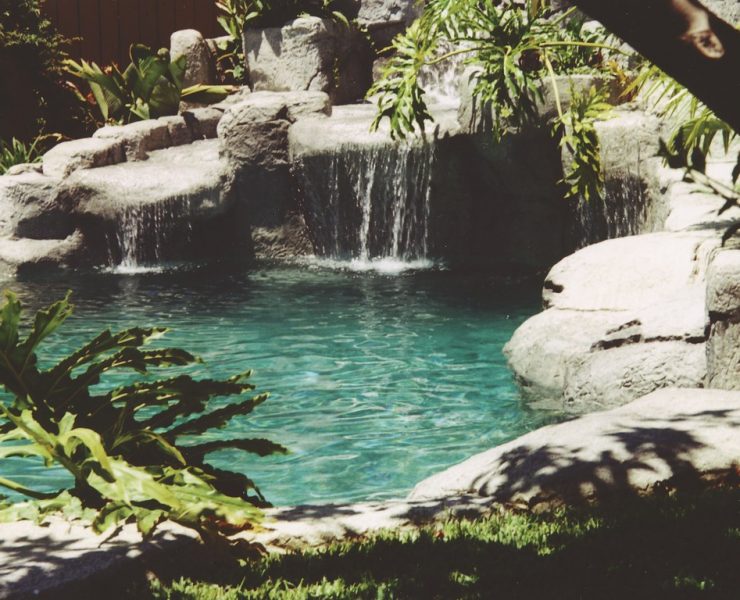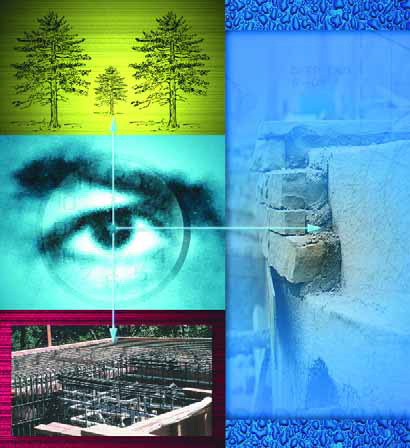pool
Some details seem simpler than they really are. A case in point is the one I'll describe this time - a detail I call a thermal ledge. In one sense, it's really just a large a big bench located a few inches below the water's surface, but in terms of what it is structurally and what it does to increase enjoyment of a pool, it's something truly special. The ledge pictured here is visually interesting in the way its stone surface picks up the rockwork used throughout the deck and the barbecue area and within the pool itself. As important, it provides the homeowners and their guests
Whether it's done using only a tape measure and a pair of experienced eyeballs or requires the help of satellites orbiting the planet, every construction project is surveyed before the work begins. In fact, surveyors have been plying their trade for thousands of years, and their services have been valued for one simple reason: It's really a good idea to measure the size and shape of the ground before you try to build on it. In today's terms, surveying is defined as the process of taking accurate measurements of the land on the X-, Y- and Z axes (that is, in three dimensions) and then translating that data into a usable (usually printed) format. There are several different surveying methods used to measure, process and communicate this critical information, and choosing the right one is essential to getting any watershaping project off to a sound start. So how do you determine the level of detail required and communicate your need to the surveyor so he or she can give you the appropriate level of information? Let's take a look at the different types of surveys in common use and review what those options mean in terms of creating a truly useful array of
It's something we in the business overlook all too often: Swimming pools, kids and summertime go together. That's why pools have been so enduringly popular, even at a time when watershapers seem to be focusing more than ever before on principles of design and how their work can be artfully integrated into the landscape. I came to building pools from an extensive background in building man-made rocks for theme parks, which has colored my perspective on the way my pools are used. I've also been swimming in backyard pools since I was a kid, and I've built all sorts of rockwork designs for all sorts of
I started my May 2001 column by expressing the belief that watershape designers should be paid for their designs in the same way interior designers and landscape designers are paid for theirs - and by indicating that lots of watershapers I've met are interested in knowing more about the mechanics of how this works. I put off addressing those issues last time because I saw a need to establish criteria for offering such services in the first place. In other words, there's much more to being a watershape designer than simply declaring yourself to be one, and I set up two dozen questions intended to clarify what I meant. Once you've answered those questions predominantly in the affirmative, once you've determined, through
In October 1999, I wrote an Aqua Culture column titled "Value by Design" in which I explained my belief that watershape designers should be paid for their designs in the same way interior designers and landscape designers are paid for theirs. Since then, I've been contacted by lots of people who are interested in knowing more about how this works; I've also had the privilege of traveling throughout the United States and abroad to talk about watershape design and construction and have met hundreds of people with the same need for information. On the one hand, it's exciting to see the notion of a watershape-design specialty catching on: It isn't a foreign idea to people the way it used to be, and
In February 1999, the cover photo on the premiere issue of WaterShapes showed a steel cage for a subgrade piling being lowered into the ground. That image was taken from a feature article by designer/builder David Tisherman, the first of many that he has contributed to the magazine. In that article and in another that followed in April 1999, he detailed the design and construction of an elaborate residential swimming pool project that he
It's natural for me to wax poetic about my work. Gardening and garden designs are what I call my "magnificent obsession" - so much so that the other arts in which I have an interest and for which I even have talent will generally take a back seat. After more than 19 years as a professional landscape designer, I am still driven and excited by the challenge of creating comprehensive landscapes for my clients. I thrive on the complexity of organizing the myriad elements required to create outdoor spaces that function properly, are beautiful and harmonious to the eye - and even touch
At our firm, we treat every project and every customer as if they're one of a kind - which in truth they are. And we've been lucky in developing a high-end clientele that, on the whole, is looking for something special: They enable us to treat each project as an individual work of art; at the same time, they challenge us to stretch our own abilities and increase the variety of design solutions we bring to the drafting table. In many cases, this requires something of balancing act between what clients think they're after and the practicalities of the site itself, the architecture of adjoining structures and the views of surrounding areas. For that reason, each of our
For me, the simplicity and elegance of the International Style was just about the best thing going in 20th-century design. The followers of Walter Gropius in the Bauhaus movement held this simplicity - expressed as a cleanness of line, a uniformity of materials and the establishment of clear relationships among architectural planes - in absolutely the highest regard. I always try to integrate these design principles into my own work - and one of the ways I do so is through the ledger detail we'll examine this time around. It's an expensive






















